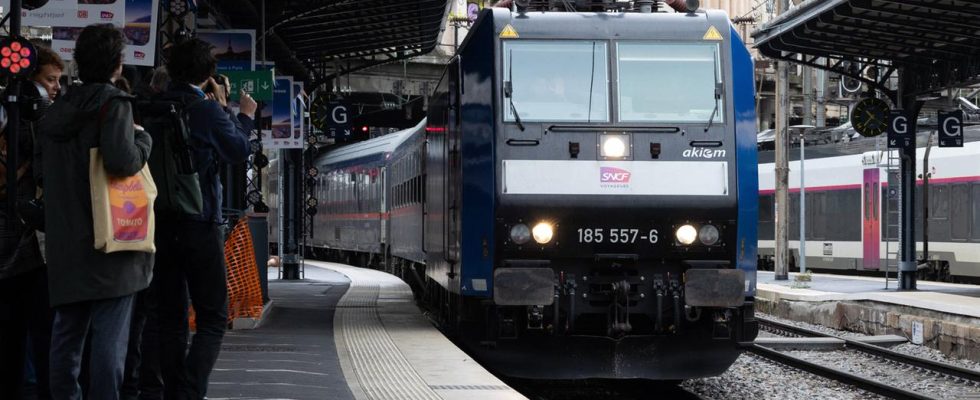background
A “Nightjet” operated by the Austrian Federal Railways now connects Berlin and Paris three times a week. The Austrian night train network is now profitable. There are few night trains in Germany.
At first there is no peace and quiet in the couchette car: the champagne corks are popping because Juliette is celebrating her 47th birthday. The Parisian invited people on a night train trip to Berlin. In a good mood, she and her friends raise a glass to the German-French friendship and are happy about the new connection.
Departure from Paris is shortly after 7 p.m. Last week the first “Nightjet” took off for Berlin. Enthusiastic night train fans sang the European anthem as a farewell and advertised further connections on colorful posters.
Meanwhile, the dark blue “Nightjet” carriages are jerking through the Paris suburbs in the drizzle. The sleeper and couchette car attendants already have their hands full: some passengers are still looking for their compartment, others are already waiting impatiently for their goulash soup. There is no dining car, but passengers are served directly at their bed.
20 Nightjet connections in Europe
Night trains are on the rise again: The Austrian Federal Railways (ÖBB), which also operates the Paris-Berlin route, have steadily expanded their network in recent years. There are more than 20 “Nightjet” connections in Europe. There are also private startups such as “European-Sleeper” on the Berlin-Brussels connection, or the Swedish State Railways SJ with a EuroNight from Berlin to Stockholm.
According to the ÖBB, tickets in the seated car are available from 34.90 euros, in the couchette car from 54.90 euros and in the sleeping car from 79.90 euros. However, prices are dynamic and can rise quickly when demand is high.
Airplane is often cheaper than the train
A Greenpeace study published in July shows: On 112 European routes examined, traveling by plane is cheaper than by train in 70 percent of cases. One reason for this is the structural disadvantage of rail compared to air transport, complains the chairman of the “Back-on-Track Germany” association, Juri Maier. The Europe-wide network is committed to more night trains.
For Germany, Maier suggests abolishing VAT for international train tickets. This is already the case in most other EU countries – and international flights are also exempt from VAT. Austria has recently shown how easy it is to change the law, said Maier.
Night trains are profitable
On the “Nightjet” from Paris to Berlin, Berlin IT student Théo is busy with his cell phone in the compartment next door. He regularly commutes to his parents in Paris, and he came across the new connection by chance. With his piercings and green hair, the French native has at least visually adapted to his adopted homeland.
The new line between the two capitals is symbolic and is their only direct rail connection. In 2014, Deutsche Bahn canceled the Paris night train before completely exiting the business in 2016. According to its own statements, it made millions in losses with its trains, some of which were more than 40 years old. It now cooperates with ÖBB and other European railways as part of a night train alliance.
At that time, the Austrians took over some lines and rolling stock from Deutsche Bahn. With success: the number of passengers in the night business continues to increase every year. With its night train network, ÖBB is now in the black and has become the market leader in Europe. They have just invested 720 million euros in 33 new “Nightjet” trains from the manufacturer Siemens.
Route prices in Germany too high?
Shortly after midnight, the train crosses the Rhine near Strasbourg and thus the border with Germany. More and more passengers are falling asleep to the rhythm of the rails. It’s getting quiet in the corridors, the champagne bottles have now been drunk. Théo also went to sleep. He is grateful for the new direct connection in the couchette car. He has often missed the last connection in Frankfurt and his journey unintentionally turned into a night journey. In Mannheim, the front part of the train heading towards Vienna is uncoupled.
What do the Austrians do differently than the Germans? Juri Maier from “Back-on-Track” sees the roots of success in a changed environmental awareness of many people. The willingness to pay more for sustainable means of transport has increased. That’s why the business is worthwhile again, says Maier. However, only a small part of society can afford tickets in sleeper and couchette cars.
In order to put more sleeping cars on the rails, route prices would have to be reduced, says Juri Maier. Although night trains in Germany have recently benefited from a reduced route tariff, they still pay twice the basic price per kilometer. Other EU countries seem to be going further here: in France, night trains are exempt from part of the route fees. In Belgium these, including energy costs, are reimbursed by the state.
State subsidized in France
When the sleeping car conductor brings the passengers breakfast in bed shortly before eight o’clock, the night train has just left Erfurt behind. The freshly brewed coffee slowly wakes Juliette and her friends up, while endless fields pass by the window in the morning mist. Arriving in Germany so gently and at a slower pace is the best thing, she says.
Even if French passengers enjoy the journey through Germany, the basic conditions for night trains in this country can still be improved. “Where there is political will, there are more railways,” writes the “Back-on-Track” network. In neighboring France, the “rolling hotels” are subsidized by the state.
A little more than an hour late, the “Nightjet” from Paris finally reached Berlin Central Station at around 10 a.m. Théo swings his large backpack onto his shoulders and waves goodbye. Juliette and her friends need a little longer. When the Parisians finally stand on the platform, they shout happily: “Bonjour Berlin!”

